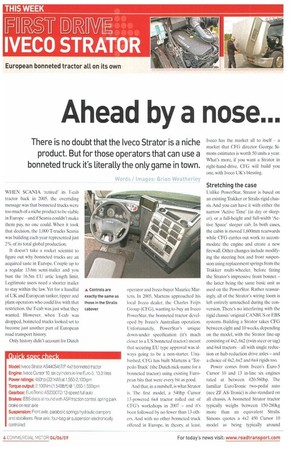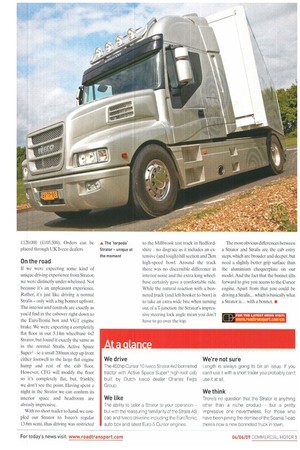Ahead by a nose...
Page 14

Page 15

If you've noticed an error in this article please click here to report it so we can fix it.
There is no doubt that the Iveco Strator is a niche product. But for those operators that can use a bonneted truck ifs literally the only game in town.
"1r "1-, Images: Brian Weathertey
WHEN SCAN1A 'retired' its T-cab tractor back in 2005, the overriding message was that bonneted trucks were too much of a niche product to be viable in Europe — and if Scania couldn't make them pay, no one could. When it took that decision, the 1,000 T-trucks Scania was building each year represented just 2% of its total global production.
It doesn't take a rocket scientist to figure out why bonneted trucks are an acquired taste in Europe. Couple up to a regular 13.6m semi-trailer and you bust the 16.5m EU artic length limit. Legitimate users need a shorter trailer to stay within the law. Yet for a handful of UK and European tanker, tipper and plant operators who could live with that restriction, the T-cah was just what they wanted. However, when T-cab was dropped, bonneted trucks looked set to become just another part of European road transport history.
Only history didn't account for Dutch operator and Iveco buyer Maurice Martens. In 2005, Martens approached his local lveco dealer, the Charles F'eijts Group (CFG), wanting to buy an Iveco PowerStar, the bonneted tractor developed by Iveco's Australian operation. Unfortunately, PowerStar's unique down-under specification (it's much closer to a US bonneted tractor) meant that securing EU type approval was always going to be a non-starter. Unabashed, CFG has built Martens a 'Torpedo Truck (the Dutch nick-name for a bonneted tractor) using existing European bits that were every bit as good.
And that, in a nutshell, is what Strator is. The first model, a 540hp Cursor 13-powered 6x4 tractor rolled out of CFG's workshops in 2007 — and it's been followed by no fewer than 13 others. And with no other bonneted truck offered in Europe, in theory. at least, Iveco has the market all to itself — a market that CFG director George Simons estimates is worth 50 units a year. What's more, if you want a Strator in right-hand-drive, CFG will build you one, with Iveco UK's blessing.
Stretching the case
Unlike PowerStar, Strator is based on an existing Trakker or Stralis rigid chassis. And you can have it with either the narrow 'Active Time' (in day or sleeper), or a full-height and full-width 'Active Space' sleeper cab. In both eases, the cabin is moved 1,600mm rearwards while CFG carries out work to accommodate the engine and create a new firewall. Other changes include modifying the steering box and front suspension using replacement springs from the Trakker multi-wheeler, before fitting the Strator's impressive front bonnet — the latter being the same basic unit as used on the PowerStar. Rather reassuringly, all of the Strator's wiring loom is left entirely untouched during the conversion. There's no interfering with the rigid chassis' original CANBUS or El3S systems. Building a Strator takes CFG between eight and 10 weeks, depending on the model, with the Strator line-up consisting of 4x2, 6x2 (twin-steer or tag) and 6x4 tractors — all with single reduction or hub-reduction drive axles — and a choice of 4x2, 6x2 and 6x4 rigids too.
Power comes from Ivcco's Euro-5 Cursor 10 and 13 in-line six engines rated at between 420-560hp. The familiar EuroTronic two-pedal auto (nee ZF AS-Tronic) is also standard on all chassis. A bonneted Strator tractor typically weighs between 150-280kg more than an equivalent Stralis. Simons quotes a 4x2 450 Cursor 10 model as being typically around
C120,000 (E1.05,500). Orders can he placed through UK Iveco dealers.
On the road
If we were expecting some kind of unique driving experience from Strator, we were distinctly under-whel med. Not because it's an unpleasant experience. Rather, it's just like driving a normal Stralis only with a big bonnet upfront. The interior and controls are exactly as you'd find in the cabover right clown to the EuroTronie box and VGT engine brake. We were expecting a completely flat floor in our 5.14m wheelbase 4x2 Strator, but found it exactly the same as in the normal Stralis Active Space Super3ie a small 200mm step up from either footwell to the large flat engine hump and rest of the cab floor. However, CFG will modify the floor so it's completely flat, but, frankly, we don't see the point. Having spent a night in the Strator we can confirm its interior space and headroom are already impressive.
With no short trailer to hand, we coupled our Strator to Iveco's regular 13.6m semi, thus driving was restricted to the Millbrook test track in Bedfordshire no disgrace as it includes an extensive (and tough) hill section and 2km high-speed bowl. Around the track there was no discernible difference in interior noise and the extra long wheelbase certainly gave a comfortable ride. While the natural reaction with a bonneted truck (and left-hooker to boot) is to take an extra wide bite when turning out of a T-j unction the Strator's impressive steering lock angle mean you don't have to go over the top. The most obvious differences between a Strator and Stralis are the cab entry steps, which are broader and deeper, but need a slightly better grip surface than the aluminium chequerplate on our model. And the fact that the bonnet tilts forward to give you access to the Cursor engine. Apart from that you could be driving a Stralis... which is basically what a Strator is... with a bonnet. •
flr),. FOR THE LATEST HEWS VISIT. 17Y.. www.roadtransport.comicm
















































































































































